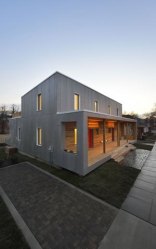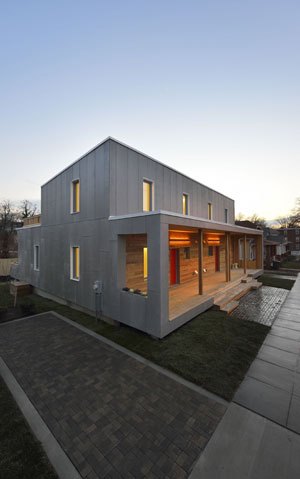
Martin SeckLakiya Culley and her sons
Lakiya Culley, an administrative assistant at the U.S. State Department and mother of three, just moved into one of the most innovative, energy-efficient houses in the U.S. – in a rather unlikely location.
Culley lives in Deanwood, a working class, primarily African American neighborhood of Washington, D.C., that has recently struggled with foreclosures. She is now the proud owner of an Empowerhouse, a home that produces all of its own energy, a feat made simpler by the fact that it consumes 90 percent less energy for heating and cooling than a conventional home.
Empowerhouse, which uses “passive house” technologies, was designed by students at the New School and Stevens Institute of Technology as part of the Solar Decathlon design competition, which was held on the National Mall in 2011. Developed in partnership with Habitat for Humanity and the D.C. Department of Housing and Community Development, the house marks the first time in the Solar Decathlon’s history that a team partnered with civic and government organizations to make a house a reality in the District.

Martin Seck
Solar Decathlon organizers added a new category so that teams could earn points for affordability after some criticism that homes were getting out-of-control-pricey and therefore weren’t realistic real-world models. A home from Germany, for example, cost upwards of $2 million. Each unit of the actual Empowerhouse in Deanwood (there are two apartments in the mini-complex), cost just $250,000, making it affordable in that neighborhood, according to a spokesperson at New School. The model, which was built by Habitat for Humanity volunteers, has been such a hit that six more are being planned for Ivy City, another inner-city neighborhood in the District.
The “net-zero” home is a marvel. The bright, bold exterior lights up the whole block. The healthy, light-filled interior is built out of sustainable, recycled materials. And the landscape architecture was integrated into the project from the beginning, said Professor Laura Briggs, faculty lead of the project at the New School. The result is stormwater management solutions that address the truly local environmental problems: the heavy runoff that impacts the already polluted rivers.
Each unit has terraces with green roofs and small plots for urban agriculture that are designed to capture some water. In the rear of each building is a rain garden that captures any rainwater that escapes from the roof gardens. Each unit also has its own underground cistern, where rainwater is collected and then used to water the property.
At the sides of the house, the parking space is made of permeable pavers that allow stormwater to sink into the underlying soils. And out front, there’s the District’s first residential green street, a deep trough filled with dirt and plants designed to soak up street runoff and deal with the oily pollutants that collect on streets. The landscape work was done with a the local organizations Groundwork Anacostia and D.C. Greenworks.
Both the homes and landscape were co-designed with the community. Students met with community members, local organizations, and Culley, the owner, in a series of design charrettes. The result of all that outreach and collaboration will be more projects in the neighborhood, including a new community “learning garden.” The designers say this was all part of creating social sustainability, a piece often left out of the puzzle.
Empowerhouse is a powerful model for how to bring sustainable, affordable, community-based housing to inner city neighborhoods, and there’s this: Habitat for Humanity now knows how to build these uber green homes in a low-cost way. No doubt we’ll be seeing more of them in unlikely locations in the future.



